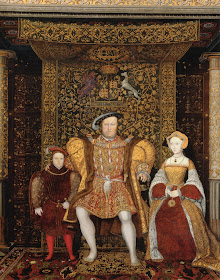 |
| Jane Seymour (left) became Henry's third wife, pictured right with Henry and the young Prince Edward, c.1545, by an unknown artist. At the time that this was painted, Henry was married to his sixth wife, Catherine Parr. |
Even if the laws in the United States are restructured to accommodate the increase in out-of-wedlock unions, the reality is that the lack of a formalized relationship will make discovering lineage very difficult for the offspring. This same situation has existed since antiquity, but the scope and scale of the changes in U.S. society are unprecedented. In a recent Pew Research Center post entitled, "Record share of Americans Have Never Married, stated as follows:
The dramatic rise in the share of never-married adults and the emerging gender gap are related to a variety of factors. Adults are marrying later in life, and the shares of adults cohabiting and raising children outside of marriage have increased significantly. The median age at first marriage is now 27 for women and 29 for men, up from 20 for women and 23 for men in 1960. About a quarter (24%) of never-married young adults ages 25 to 34 are living with a partner, according to Pew Research analysis of Current Population Survey data. See also U.S. Census Bureau table MS-2. (http://www.census.gov/hhes/families/data/marital.html) and Analysis is based on March 2013 Current Population Survey.Documenting a population that has no formal marriage records may become impossible.

No comments:
Post a Comment